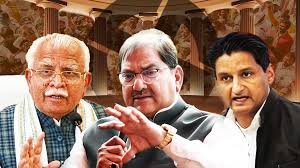As Haryana gears up for its 2024 Assembly elections, political parties are leaving no stone unturned to secure victory in this crucial northern state. The election, scheduled to be held in a single phase, promises to be a fierce battleground for both national and regional players. With the Bharatiya Janata Party (BJP) aiming to retain power and the Congress party seeking to reclaim lost ground, the contest is expected to shape the political landscape not just in Haryana but also at the national level.
The Political Landscape of Haryana
Haryana, known for its unique political dynamics, has historically been a stronghold of regional as well as national parties. Over the years, both the BJP and the Congress have dominated the political arena, with the Indian National Lok Dal (INLD) and its offshoot, the Jannayak Janta Party (JJP), playing significant roles as well.
The BJP, under the leadership of Chief Minister Manohar Lal Khattar, is contesting to retain its hold over the state, after having governed for nearly a decade. Khattar, a non-Jat leader, has been the face of the BJP’s inclusive governance, and the party is banking on his image to sway voters in this election.
The Congress, on the other hand, is pinning its hopes on reviving its fortunes under the leadership of former Chief Minister Bhupinder Singh Hooda. Hooda’s leadership has strong appeal among the state’s Jat community, a key voting bloc in Haryana politics. The party has intensified its campaigning efforts, aiming to capitalize on perceived public dissatisfaction with the BJP’s governance.
Key Issues Dominating the Election
Several pressing issues are likely to dominate voter sentiment in the upcoming elections. Among the top concerns is the state of the agricultural economy. Haryana, being an agriculturally significant state, has a large rural voter base, many of whom were active participants in the farmers’ protests against the now-repealed farm laws. While the farmers’ agitation has ended, its impact on the political discourse remains substantial, with rural voters still voicing concerns about agricultural policies, minimum support prices (MSP), and crop insurance.
Unemployment, particularly among the youth, is another critical issue. Despite Haryana’s industrial growth, the unemployment rate in the state has remained high. Both the BJP and Congress have promised job creation and economic development in their manifestos, with a focus on addressing the needs of the state’s young voters.
Infrastructure development is another key issue, particularly in urban areas like Gurugram and Faridabad, which have seen rapid growth. However, concerns about inadequate public services, poor roads, and issues related to pollution continue to plague these areas. Both major political parties are promising significant improvements in infrastructure to attract urban voters.
The Role of Regional Parties
While the BJP and Congress are the primary contenders, the role of regional parties cannot be underestimated. The JJP, currently in alliance with the BJP, has a significant influence in the state, particularly in rural and semi-urban areas. Led by Dushyant Chautala, the party will be a crucial factor in determining the outcome of several key constituencies.
The INLD, once a formidable political force in Haryana, has seen its influence wane over the years. However, with the political legacy of former Deputy Prime Minister Devi Lal still resonating in some parts of the state, the party may yet surprise the major players by securing key votes in rural constituencies.
Caste and Community Dynamics
Haryana’s electoral landscape is heavily influenced by caste dynamics, with the Jat community playing a pivotal role in determining the outcome. The Jats, who make up nearly 28% of the state’s population, have traditionally supported the Congress and regional parties like the INLD. However, in recent years, the BJP has made significant inroads among non-Jat voters, particularly in urban areas and among other backward classes (OBCs).
The BJP’s strategy of appealing to non-Jat voters, along with its focus on development and governance, has helped it build a broad coalition of support. However, the Congress remains hopeful of leveraging the strong Jat vote bank, particularly with Hooda at the helm, to mount a strong challenge.
The Road Ahead
As the single-phase polling day approaches, all eyes will be on the political strategies deployed by the major contenders. For the BJP, the challenge lies in retaining its grip on power, especially in light of public dissatisfaction over issues like unemployment and the farmers’ agitation. The party is banking on its development agenda, as well as the governance track record of Chief Minister Manohar Lal Khattar, to counter the opposition.
For the Congress, the key will be to consolidate the Jat vote while also reaching out to non-Jat voters and urban constituencies. The party is focusing on portraying itself as the more experienced alternative to the BJP, emphasizing issues of economic distress and governance failures under the current administration.
Conclusion
The 2024 Haryana Assembly elections are shaping up to be one of the most closely watched political events of the year. With both the BJP and Congress vying for supremacy, the outcome of this election will have significant implications not only for Haryana but also for national politics. As voters prepare to cast their ballots, the political parties are working tirelessly to sway public opinion, with the stakes higher than ever in this fiercely contested election.
Haryana’s political future will be determined in this single-phase election, and the results could set the tone for the broader political landscape leading up to the national general elections in 2024. For now, the political climate in the state remains charged, with all players ready for the final showdown at the polls.


